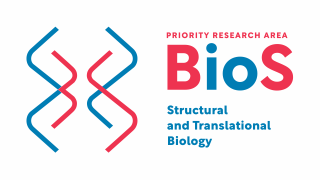The grant awarded to the BioS PRA and the activities undertaken by the PRA’s members are aimed at achieving a high level of internationally recognisable research in the fields indicated below.
1. STRUCTURAL BIOLOGY
Research field scope: Structural biology focuses on research aimed at understanding the spatial structure of organic and inorganic molecules important in biology, as well as their dynamics and interactions. It also studies molecules produced by humans from elements similar to biological molecules. Given the diversity and complexity of the research problems in this area, it is important to use a variety of techniques to obtain information in high (for example, cryo-EM microscopy) and low resolution or to apply indirect inference based on all relevant techniques used in biology, chemistry, physics, and related sciences, as well as computational methods. Since these research techniques are complementary, a hybrid approach is justified, which consists in inferring about the system under analysis based on results obtained using several techniques.
Examples of subject areas within the research field:
- Comprehensive analysis of the spatial structure and dynamics of a biomacromolecular system, using direct imaging, indirect inference with integration methods, and computational methodology
- Analysis of the relationship between structure and function in macromolecular biological systems and the interaction of macromolecules with small chemical molecules, using high-resolution imaging and kinetic, thermodynamic and spectroscopic analysis
- Analysis of the structure of a micromolecular complex, using mass spectrometry, immunoprecipitation and immunodetection, and cell engineering, with and high-resolution characterisation of selected components of the complex
2. OMICS & BIOINFORMATICS
Research field scope: Technological development in the area of ‘omic’ research (such as genomics, proteomics, transcriptomics, metabolomics, lipidomics) and bioinformatics has opened up new opportunities for biologists working in a vast field, both in basic research and research with application potential. It is also an excellent example of synergy resulting from interdisciplinary collaboration between geneticists and specialists in computational biology. Big data combined with machine learning methods make it possible to identify genotypic and phenotypic characteristics, and this, in turn, creates opportunities for the development of personalised medicine and the improvement of the quality of life.
Examples of subject areas within the research field:
- Application of meta-analyses in research on molecular interactions
- Fundamentals of the variability and evolution of phenotypic characteristics
- Application of high-capacity and targeted analyses in research on gene functions
3. CELL, SYSTEMS AND TRANSLATIONAL BIOLOGY
Research field scope: Research at the level of plant and animal cells, including, among others, studying the physiological, pathological and therapeutic mechanisms. In particular, research into cellular processes, cell-to-cell interactions, and cell/organism responses to environmental factors, using model organisms, as well as research into chemical imaging in tissues and cells, and translational biology.
Examples of subject areas within the research field:
- Research into physiological and pathological mechanisms at the molecular, biochemical or functional level, in in vitro, ex vivo and in vivo models
- Research into pharmacotherapeutic mechanisms that can bring new ways of disease treatment and prevention in in vitro, ex vivo and in vivo models
- Use of the results of basic research towards research with application potential
4. EVOLUTIONARY BIOLOGY AND BIODIVERSITY RESEARCH
Research field scope: The study of evolutionary processes and processes shaping global and local biodiversity patterns. Apart from its cognitive importance, such research provides the basis for developing strategies to minimise the impact of anthropogenic factors on biodiversity and the functioning of ecosystems and the whole biosphere.
Examples of subject areas within the research field:
- The functioning of ecosystems in the Anthropocene
- Biodiversity patterns
- Applied conservation biology
5. BIOLOGY OF CONFLICT AND COOPERATION
Research field scope: Understanding the relations between organisms in systems with different types of interactions, especially antagonistic (e.g. pathogen-host) and symbiotic (e.g. microbiome-host, mycorrhiza). Experimental research and theoretical modelling of the mechanisms of infection, defence and tolerance and their evolution. (Pato)physiological consequences of interactions.
Examples of subject areas within the research field:
- Mechanisms of interaction of prokaryotic and eukaryotic cells with pathogens and symbionts
- Characterisation of diseases and changes in gene expression in response to stress caused by pathogens or symbionts
- Modelling coevolution in antagonistic and symbiotic systems


 Web Content Display
Web Content Display
Web Content Display
Web Content Display
 Web Content Display
Web Content Display
Web Content Display
Web Content Display


 Navigation
Navigation
Navigation
Navigation
 Web Content Display
Web Content Display
Web Content Display
Web Content Display